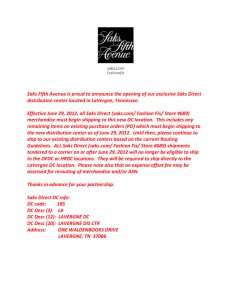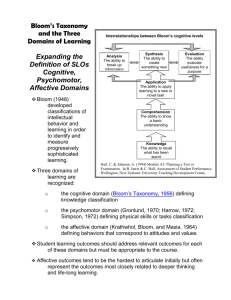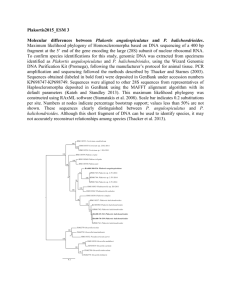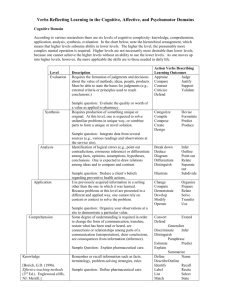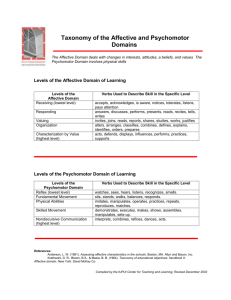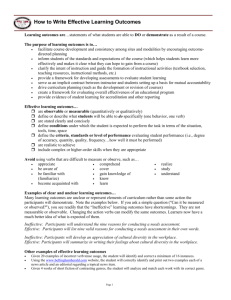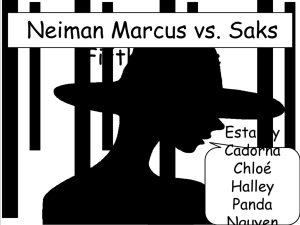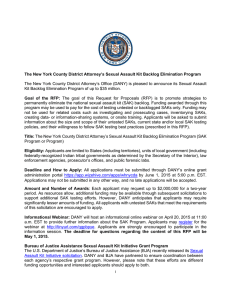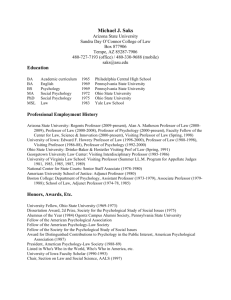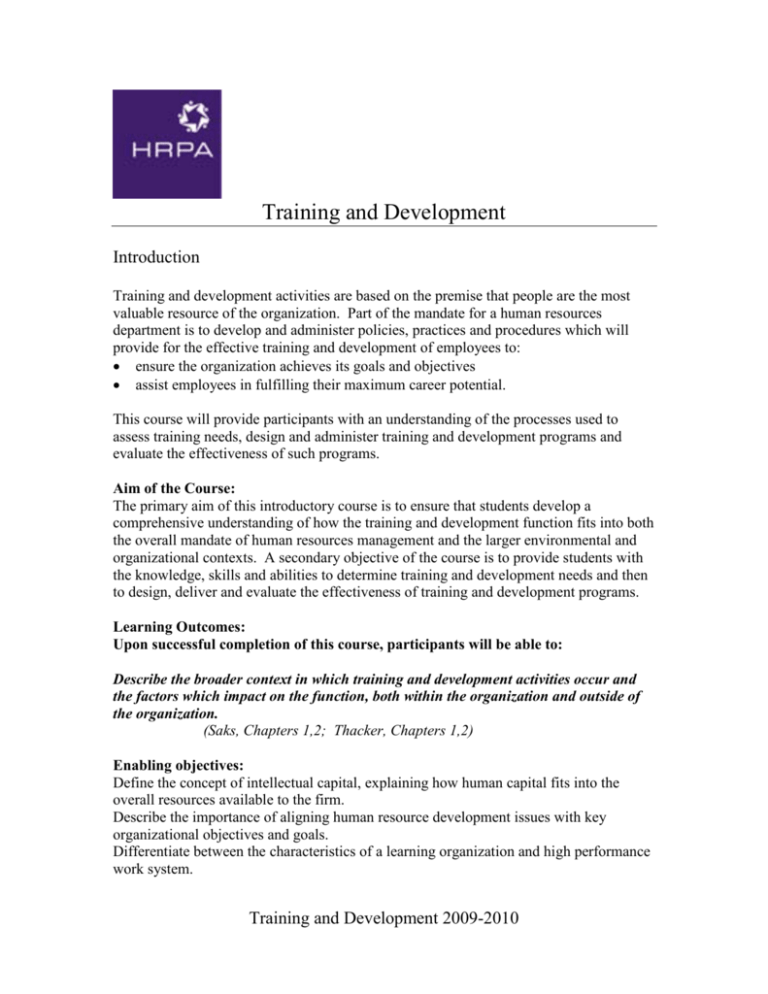
Training and Development
Introduction
Training and development activities are based on the premise that people are the most
valuable resource of the organization. Part of the mandate for a human resources
department is to develop and administer policies, practices and procedures which will
provide for the effective training and development of employees to:
• ensure the organization achieves its goals and objectives
• assist employees in fulfilling their maximum career potential.
This course will provide participants with an understanding of the processes used to
assess training needs, design and administer training and development programs and
evaluate the effectiveness of such programs.
Aim of the Course:
The primary aim of this introductory course is to ensure that students develop a
comprehensive understanding of how the training and development function fits into both
the overall mandate of human resources management and the larger environmental and
organizational contexts. A secondary objective of the course is to provide students with
the knowledge, skills and abilities to determine training and development needs and then
to design, deliver and evaluate the effectiveness of training and development programs.
Learning Outcomes:
Upon successful completion of this course, participants will be able to:
Describe the broader context in which training and development activities occur and
the factors which impact on the function, both within the organization and outside of
the organization.
(Saks, Chapters 1,2; Thacker, Chapters 1,2)
Enabling objectives:
Define the concept of intellectual capital, explaining how human capital fits into the
overall resources available to the firm.
Describe the importance of aligning human resource development issues with key
organizational objectives and goals.
Differentiate between the characteristics of a learning organization and high performance
work system.
Training and Development 2009-2010
Differentiate between organizational development, training, performance management
and management development.
Using a systems perspective, identify ways to improve the knowledge management
practices of a firm.
Describe trends in the types of common training programs provided by Canadian
organizations.
Describe organizational benefits which can result from training and development
activities from organizational, individual and societal perspectives.
Discuss recent trends and patterns affecting training activities in Canada.
Discuss the impacts of the external environment on training activities.
Explain how the learning model adopted can impact on an organization's training and
development activities.
Explain why it is important to effectively position the training function within an
organization.
Describe the steps typically involved with the training cycle using the ISD approach.
Explain typical issues encountered in managing the training function.
Describe alternative methods used to structure the training function using both
centralized and decentralized approaches in either a line, staff or consulting capacity.
Describe various issues involved with outsourcing the training function.
Describe the roles which external providers can play in providing training and
development services (federal, provincial and municipal governments, educational
institutions, professional associations).
Effectively incorporate learning theory into the design, delivery and evaluation of
training programs.
(Saks, Chapter 3; Thacker, Chapter 3)
Enabling objectives:
Define the concept of learning.
Differentiate among cognitive, behavioural and social learning approaches.
Differentiate between pedagogical and androgogical approaches to learning and training
design.
Describe the impact of motivation and self efficacy on both performance and training.
Describe common learning styles and their impact on training design and delivery.
Design training programs to overcome common sources of training resistance.
Effectively conduct a training needs analysis.
(Saks, Chapter 4; Thacker, Chapter 4)
Enabling objectives:
Define the concept of needs analysis
Describe why needs analysis should be done.
Describe the three levels (individual, job, organizational) at which needs analysis should
occur.
Describe common performance problems.
Differentiate between root causes and symptoms of performance problems.
Training and Development 2009-2010
Determine possible solutions for the root causes of performance problems.
Using Mager and Pipe's model, differentiate between performance problems which might
be solved through training and those requiring alternative approaches.
Apply appropriate techniques to conduct a needs analysis.
Describe the steps involved in the diagnostic process.
Compare common needs assessment techniques, outlining the advantages and
disadvantages of each .
Analyze and interpret data gathered from a needs assessment.
Develop a competency profile for a job, differentiating among knowledge, skill and
attitudinal requirements.
Design effective training programs.
(Saks, Chapter 5; Thacker, Chapter 4)
Explain the factors which affect effective program design.
Describe the decision making process involved with make or buy decisions.
Describe how to identify appropriate training content.
Formulate training objectives.
Formulate opinions on trainer appropriateness.
Formulate a request for proposal (RFP).
Describe the principles which should be embedded within the design of a training
program to improve its effectiveness.
Utilize Gagne -Briggs model to improve training design.
Critique a training program to determine opportunities to improve its design.
Describe how the training roll out - methods, materials, site, scheduling can impact on the
effectiveness of the training.
Describe the concept of a lesson plan
Practice developing a lesson plan for a training objective.
Practice delivering a training module using a variety of techniques.
Effectively employ off-the-job training methods.
(Saks, Chapter 6; Thacker, Chapter 6,7)
Describe the common training techniques commonly used in off the job training
situations: lecture, discussion, behavioural modelling, technology based training, cases,
games, simulations, role plays, and action learning.
Discuss the advantages and disadvantages of each method.
Outline how to effectively use each method.
Choose a training method which effectively supports the training objectives.
Effectively employ on-the-job training methods.
(Saks, Chapter 7,8; Thacker, Chapter 6,7)
Training and Development 2009-2010
Describe common training techniques commonly used in on the job training situations:
performance aids, job instruction training, apprenticeship, job rotation, electronic
performance support systems, coaching, mentoring, self directed learning
Discuss the advantages and disadvantages of each method.
Outline how to effectively use each method.
Choose a training method which effectively supports the training objectives.
Describe the specific challenges associated with using technology and e-learning
effectively, whether on or off the job.
Improve the likelihood of delivering an effective training program.
(Saks, Chapter 9, 10; Thacker, Chapter 8)
Describe the process of transfer of training.
Apply the concept of transfer of training, differentiating between horizontal and vertical
transfers.
List the methods that can be used to increase transfer before, during and after a training
program.
Identify ways to improve the training site, trainer style and behaviour and other common
delivery problems.
Identify opportunities to create an enhanced learning culture in a specific situation.
Apply Gagne’s’s model to a training situation to improve training effectiveness.
Evaluate the effectiveness of training initiatives
(Saks, Chapter 11,12; Thacker, Chapter 9)
Explain why evaluation is a very important component of the training cycle
Describe the reasons why trainers might not conduct evaluations.
List the four types of evaluations considered under Kirkpatrick's framework and give an
example of how each could be measured.
Apply the COMA model.
Discuss challenges associated with data collection.
Assess strengths and weaknesses associated with common evaluation frameworks.
Describe issues which may impact on the evaluation process
Develop an evaluation approach appropriate for a given training situation.
Describe a model approach for assessing the impact of a training program on
organizational effectiveness.
Describe the importance of costing training and development programs from both short
and long term perspectives.
Describe the similarities and differences among common approaches to measuring the
cost of training: training costing sheets, cost analysis worksheets, net benefit value
calculations, cost/benefit analysis, ROI, utility analysis.
Identify situations in which each approach could be used most effectively.
Develop a training costing sheet
Develop a cost analysis worksheet for a training situation.
Estimate training net benefit values by developing a worksheet.
Develop a utility analysis for a training situation.
Training and Development 2009-2010
Recommended Texts:
Saks, Alan and Haccoun, Robert, Managing Performance ThroughTraining and
Development, 5th ed., (2010). Scarborough: Nelson Education Series in Human
Resource Management, ISBN: 13-978-0-17-650176-1
Or
Blanchard, Nick P., Thacker, James W., Effective Training, 4th edition (2010), Pearson
Prentice Hall, Upper Saddle River New Jersey, ISBN-13: 978-0-13-607832-6
Training and Development
Sample Challenge Exam Questions
Part A - Compare and contrast between these terms (say how they are the same, how they
are different):
1. Training and development
• Both refer to attempts to enhance knowledge, skills, attitudes, behaviours of
employee to add to intellectual capital/human resource value of firm
• Training typically short term, skill oriented, directed at current position
• Development typically longer term in scope, focus is on future potential in
future positions (enhancing value of future intellectual capital).
2. Direct training costs and indirect training costs
• Both need to be monitored to assess the value of training initiative and often
to justify the initial investment.
• Direct costs include costs associated with the design, delivery of the training
program (also often known as hard costs), often more easily assessed,
measured: facilitator contract, books and materials, room and food, audiovisual equipment
• Indirect costs include items which are often not as readily apparent but which
often represent the costs associated with not doing the training (higher scrap
levels, elevated levels of absenteeism, poor morale, sometimes known as soft
Training and Development 2009-2010
costs). Both types of costs are important to track in order to justify the training
investment and to perform complete cost/benefit analysis. Organizations often
overlook soft costs which may provide additional data needed to justify
training investment and meet break even/ROI targets.
Part B - Short Answer Questions:
3. How could a manager use Pipe and Mager's flow diagram to identify training
opportunities?
• Focus of this model is on determining solutions to performance problems.
• Important not to assume that each and every performance problem can be
rectified by training.
• Systematic process for examining the likely sources of performance
deficiencies and the possible actions which can be taken, depending upon the
likely cause.
• First level assessment focus is on the relative importance of the issue, next
level focus is on whether or not it relates to a skill deficiency. If not a skill
deficiency, (attitude, job design) most effective actions are likely to be other
than training (punishment, positive consequences, removal of obstacles).
• If likely cause is due to a skill deficiency, this is where training will be most
effective intervention strategy.
• Assists manager in identifying type of training intervention which is likely to
be most effective for correcting the performance gap based upon the
frequency of the skill use, past levels of skill, and the employee's future
potential/likelihood of
• mastery.
4. How could training programs be linked with organizational strategy?
• Can use top down or bottom up process, both serve to ensure alignment of
training efforts and organizational strategy.
• Important to ensure there is alignment at every level to ensure training initiatives
will be effective If top down, often involves a management by objectives
approach whereby each level of organization asked to reflect on contribution can
make given predetermined accountability and responsibility levels. Alignment
with overall business objectives ensures training is rolled out and connected to
each aspect of business operation which is touched by training (ex. corporate
strategy, departmental and functional objectives, job standards and expectations,
instructional objectives, performance standards, records, performance problems
identified). Will cascade down.
• Bottom up approaches typically initiated by a concern with employee
performance or productivity (weaknesses or effectiveness concerns)
• Often accompanied by very specific training objectives designed to close the
performance gap and ensure behaviour, skills, activities are contributing
effectively to job expectations, departmental performance and ultimately up to
organizational strategy.
Training and Development 2009-2010
Training & Development –Multiple Choice Sample Questions
Section A - Multiple Choice
1. Training is most effective in resolving:
Skill gaps
Attitudinal problems
Poor motivation
Attendance issues
2. The term which describes long term training which includes a combination of both
on-the-job and in-class training is:
Mentorship
Computer based training
Vestibule training
Apprenticeship
3. Which item is NOT an example of an indirect training cost?
Training and Development 2009-2010
Overtime
Increased scrap
Room and food charges
Low productivity
4. The phrase "transfer of training" refers to:
Moving training schedules around to accommodate production
concerns
Freely sharing written training material with colleagues
Acquiring and evaluating skills during a training course
Implementing and maintaining new knowledge and skills back
in the workplace
5. Labour Market adjustment services refers to the stakeholder interests of:
Supply side training such as anticipated shortages for particular trades
Skill mismatches
Those who have difficulty entering or reentering the workforce
Those who have suffered a job loss
6. A key principle of adult learning suggests that adults:
Are keenly open to change
Tend to be problem centred
Do not need theoretical knowledge, just practical applications
Prefer a relaxing "lecture style" training delivery
7. The evolution of training activities has moved towards:
Specific on the job requirements using technology as the learning coach
Time and motion studies
Needs driven by productivity and efficiency concerns
Identifying opportunities to build intellectual capital
8. The motivational component of self efficacy:
Is when a person believes they can manipulate their environment and control
their fate
Is when a person believes they can learn the knowledge and skills and do the
job
Relates to the ability to use fine motor skills
Training and Development 2009-2010
9. The diagnostic process of needs assessment often starts with:
A job analysis
A gap analysis
A concern
An organizational audit
10. A potential advantage of centralizing the training function is that:
Control and economies of scale
Customization and ownership
Local budget control
11. One of the differences between pedagogy and androgogy is that:
Adult motivation is primarily intrinsic not extrinsic
Adults are keenly receptive to change
Adults are oriented to learning using a subject centred approach
12. Interpretive analysis:
Focuses on the processes used to achieve organizational goals
Uses talk (accounts, stories, metaphors) as the primary data collection method
Is a method of job analysis
13. Large scale training initiatives such as sexual harassment or health and safety
training, are likely the result of needs analysis at:
The job analysis level
The organizational analysis level
The personnel analysis level
14. When structuring training objectives, the trainer should:
Give trainees a clear understanding of what to expect
Isolate all learning objectives in a single learning domain
Encourage trainees to evaluate whether they can omit certain
course objectives
15.An example of a technical barrier to effective performance is:
Group norms
Training and Development 2009-2010
Poor job design
Ineffective feedback
16. Training works best under which of the following conditions:
The task is easy and perfection is not required
Correct performance is critical
The task is infrequently performed
17. Which of the following matching pairs is correct?
Affective - heart; cognitive - head
Cognitive - heart; affective - head
Psychomotor - hand; affective - head
Psychomotor - head; affective – heart
18. The cognitive domain hierarchy of learning starts with:
Knowledge
Receiving
Perception
Motivation
19. Bloom's Taxonomy divides specific learning objectives into these three categories of
educational objectives:
Knowledge, comprehension and application
Cognitive, affective and psychomotor
Receiving, responding and valuing
20. Considering the principles of adult learning, adults should:
Be graded on a curve, the normative approach of comparing learners with one
another for the purposes of ranking
Be evaluated against attainment of specific criteria and not compared publicly
to their peers
Be evaluated on personal progress against historical mastery levels,
critieron
related evaluation
21. This learning objective "Develop a lesson plan or outline" is, at the highest level,
primarily under the _______domain and the ________level.
Cognitive - synthesis
Psychomotor - guided response
Cognitive - comprehension
Training and Development 2009-2010
22. The interaction style that refers to learners expecting the trainer to be primarily
responsible for the learning that occurs is:
Collaboration
Dependence
Independence
23. Examples of areas of quantifiable change for a level four results evaluation are:
Work climate and attitudes
Turnover and productivity
Feelings and decision making skills
24. Evaluation of training programs to determine how the process and outcomes can be
improved is:
Summative evaluation
Formative evaluation
Net cost analysis
25. Evaluation of training programs should happen:
Only at the end
By predetermining the evaluation criteria at the planning stage
For high cost programs only
Training and Development Solutions –Multiple Choice
1. skill gaps
2. Apprenticeship
3. Room and food changes
4. Implementing and maintaining new knowledge and skills back in the workplace
5. Those who have difficulty entering or reentering the workforce
6. Tend to be problem centered
7. Specific on the job requirements using technology as the learning coach
8. Is when a person believes they can learn the knowledge and skills and do the job
9. A concern
10. Control and economics of scale
11. Adult motivation is primarily intrinsic not extrinsic
12. Uses talk
13. The organizational analysis level
14. Give trainees a clear understanding of what to expect
Training and Development 2009-2010
15. Poor job design
16. Correct performance is critical
17. Affective-heart; cognitive-head
18. Knowledge
19. Knowledge, comprehension, application
20. Be evaluated against attainment of specific criteria and not compared publicly to their
peers
21. Cognitive-synthesis
22. Dependence
23. Turnover and productivity
24. Summative evaluation
25. Be predetermining the evaluation criteria at the planning stage
Training and Development 2009-2010

